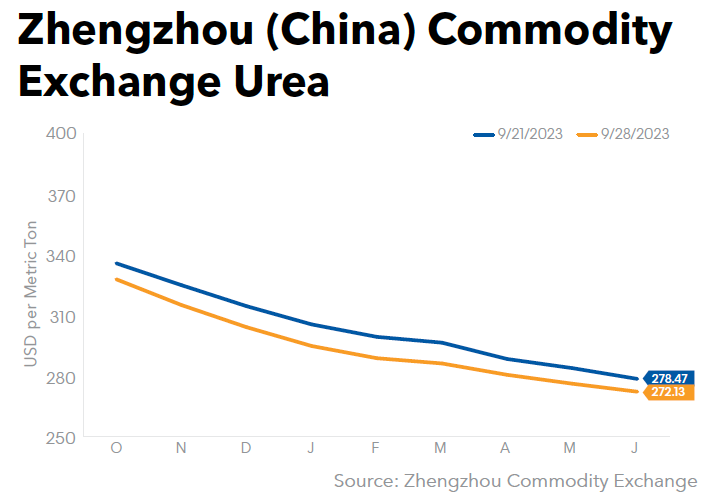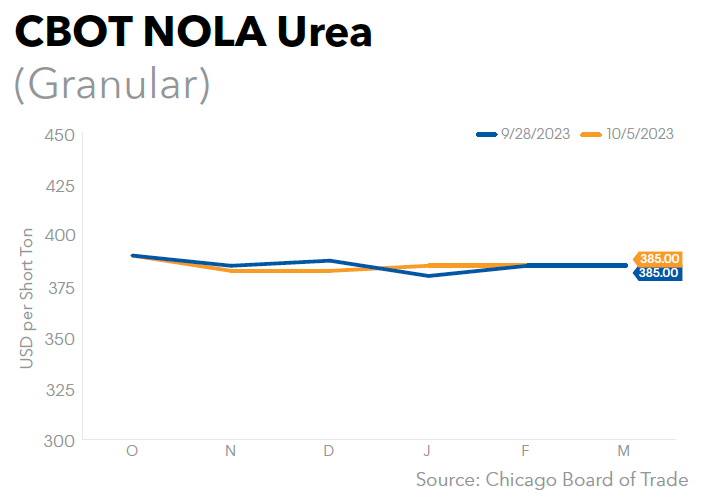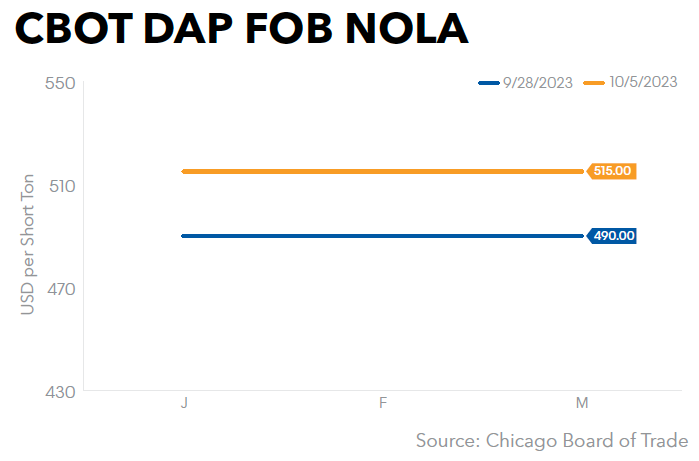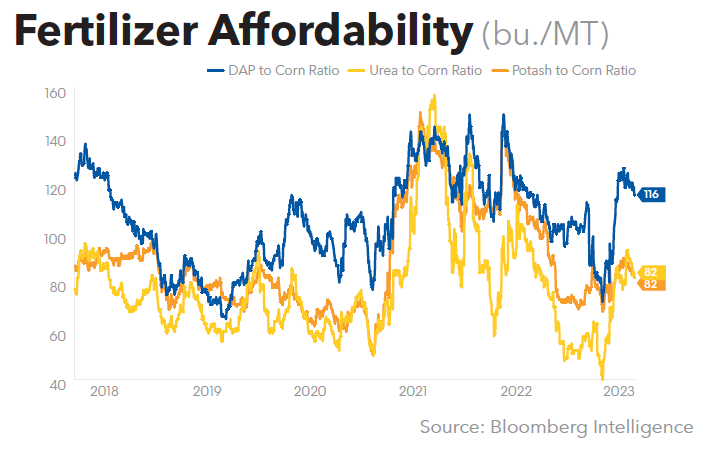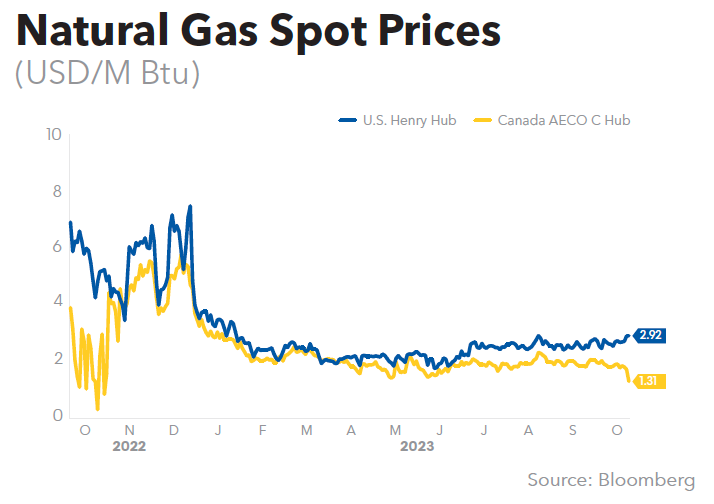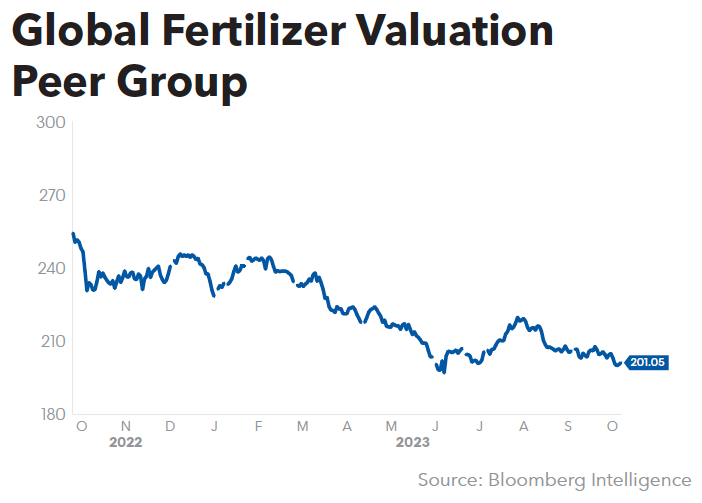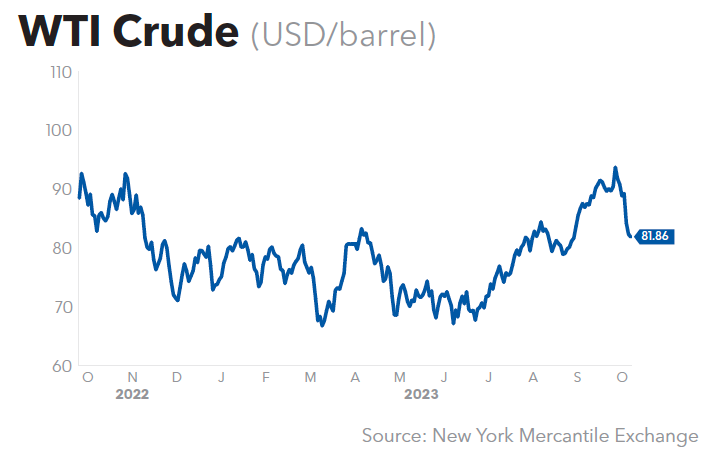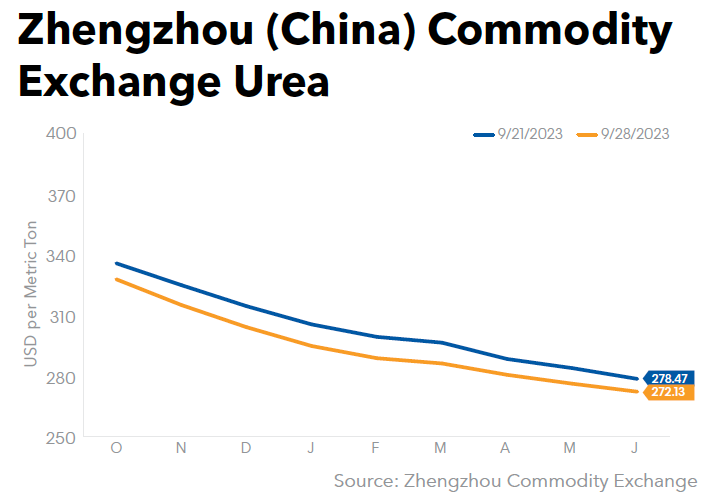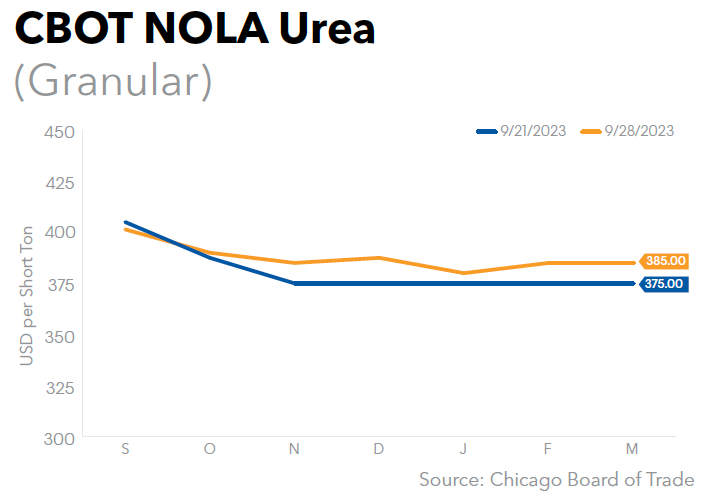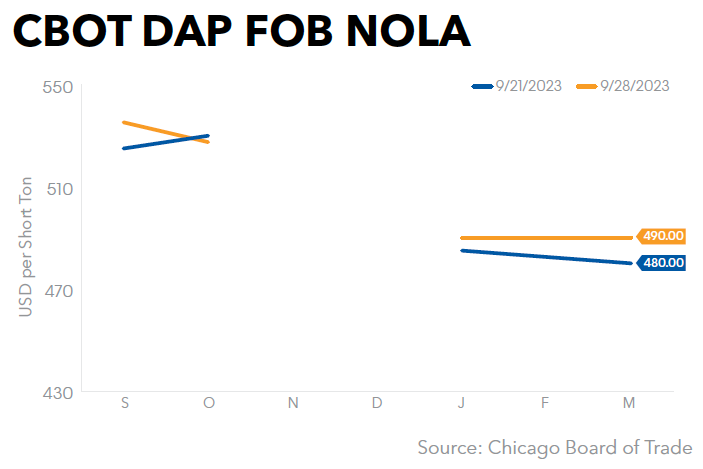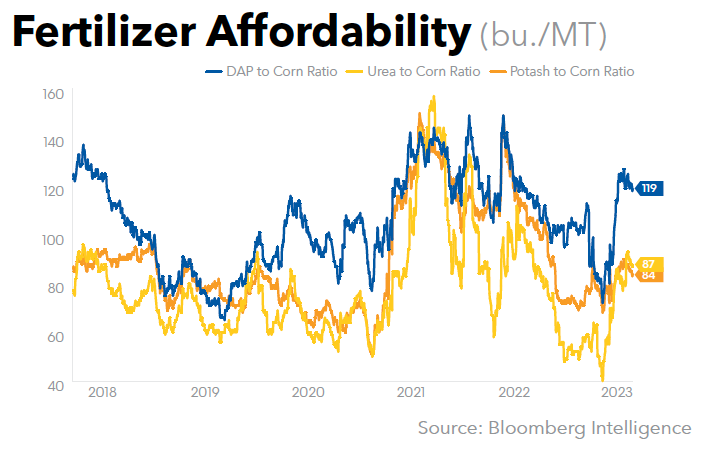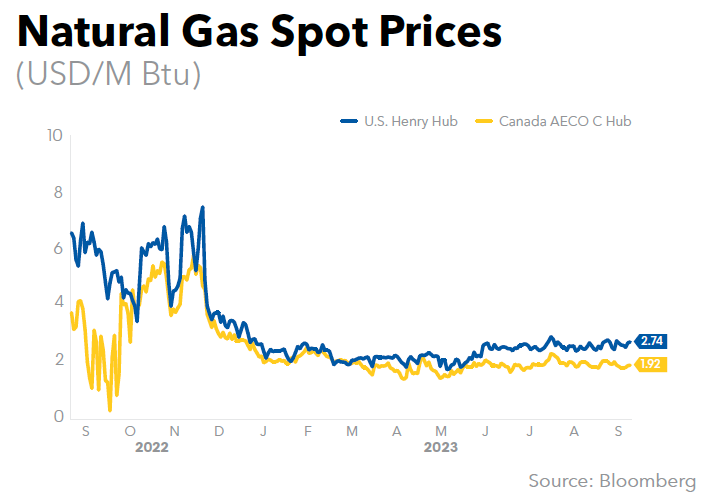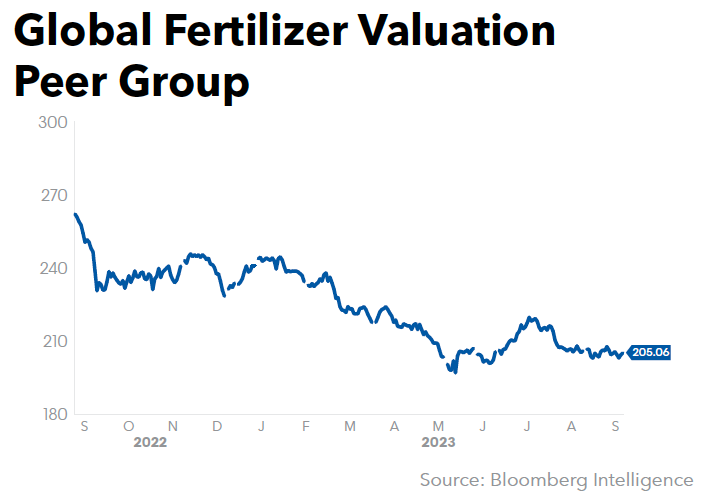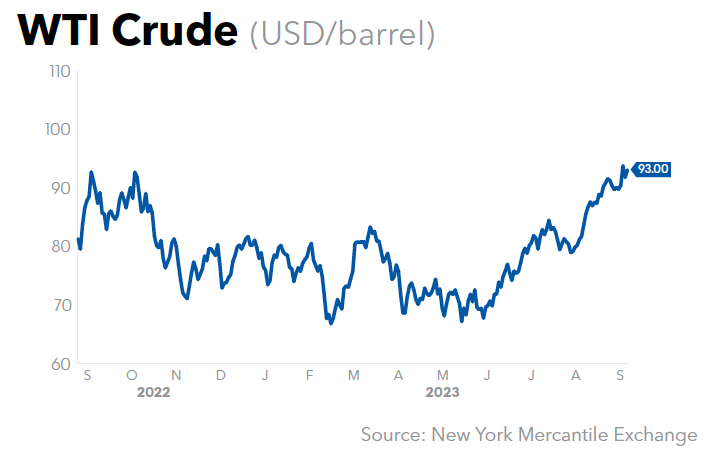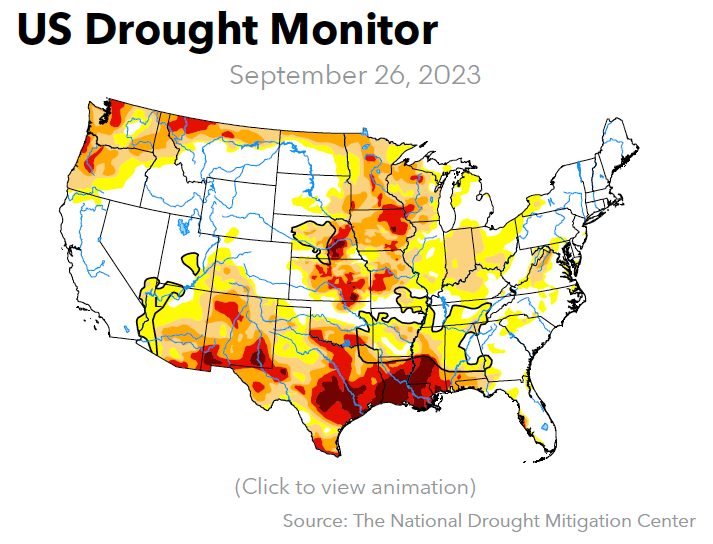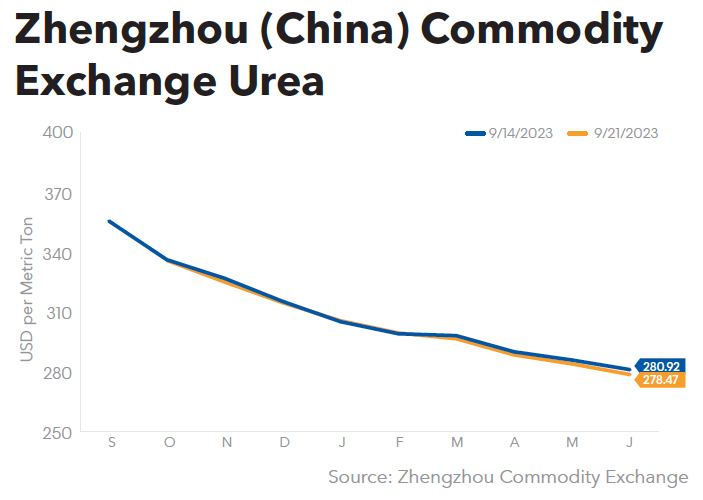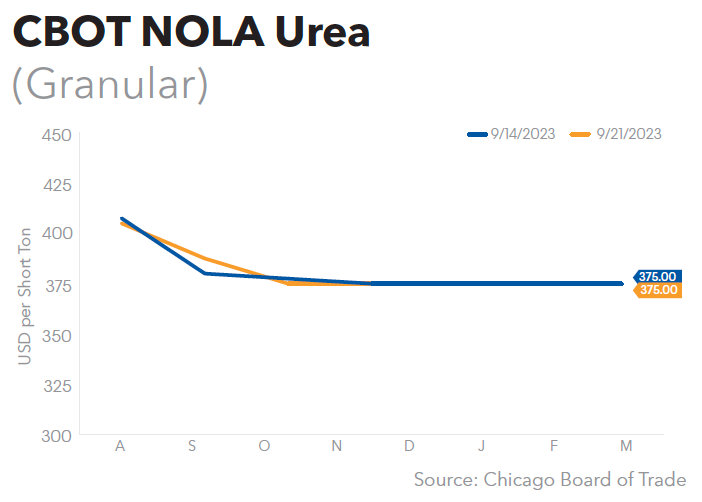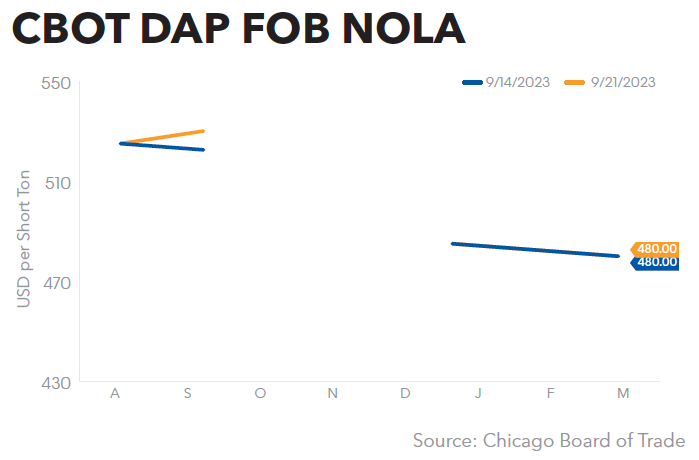| 10/6/2023 | Last Week | |
| Memphis | 18.50-19.00 | 18.50-19.00 |
| St. Louis | 20.00 | 20.00 |
| Peoria | 27.00-28.50 | 27.00-28.50 |
| Cincinnati | 30.00 | 30.00 |
| St. Paul | 33.00 | 33.00 |
| Catoosa/Inola | 36.00 | 36.00 |
All posts by jlarareo@bloomberg.net
Fertilizer Futures
Data Signals
Dry Fertilizer Barge Rates
| 9/29/2023 | Last Week | |
| Memphis | 18.50-19.00 | 18.50-19.00 |
| St. Louis | 20.00 | 20.00 |
| Peoria | 27.00-28.50 | 27.00-28.50 |
| Cincinnati | 30.00 | 30.00 |
| St. Paul | 33.00 | 33.00 |
| Catoosa/Inola | 36.00 | 36.00 |
Fertilizer Futures
Data Signals
Crops/Weather
Eastern Cornbelt:
Scattered showers were reported in all three states at midweek, but dry weather was on tap for the weekend, along with highs in the 70s and 80s.
The harvest of corn and soybeans was off to a slow start in the region, with progress trailing the five-year average. Illinois growers had 6-10% of the corn and soybeans harvested by Sept. 24, compared with 7% in Indiana, 2-3% in Ohio, and 1-2% in Michigan.
Ohio continued to report the best crop conditions, with 68-72% of the corn and beans rated as good or excellent, compared with 63% in Indiana, 60-61% in Illinois, and 49-56% in Michigan.
Western Cornbelt:
The Western Cornbelt was bracing for a heat wave over the coming weekend, with highs expected to reach the upper-80s and low-90s across eastern Nebraska, western Iowa, and northern Missouri. Forecasts warned of record highs for some locations, with the heat expected to roll over into Monday, Oct. 2.
While not helpful for the region’s ongoing drought, the hot, dry conditions made for great harvest weather. Missouri’s corn harvest was 28% complete by Sept. 24, compared with 15% in Nebraska and 9% in Iowa, while the soybean harvest had progressed to 11-14% complete in Iowa and Nebraska and 4% in Missouri. Some 45-50% of the corn and beans in Iowa and Nebraska were rated as good or excellent, ahead of Missouri’s 33-44%.
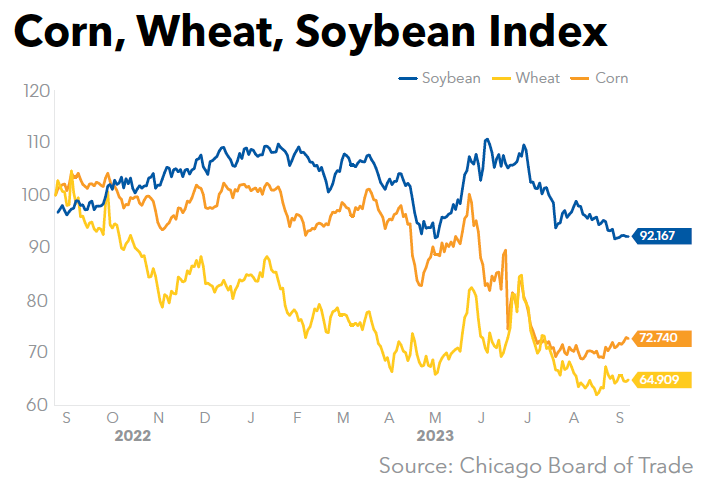
Nebraska growers also had 6% of the sorghum harvested by Sept. 24, with 63% of the acreage rated as good or excellent. Missouri’s rice crop was 27% harvested by that date, while the Missouri cotton harvest was just 2% complete, with 64% of the crop rated as good or excellent.
California:
The week began with a Pacific system that brought heavy rain to coastal areas of Northern California, with more than two inches reported in Crescent City and Eureka but just a trace of precipitation farther south in Sacramento and San Francisco. Southern California was missed entirely by the storm.
Crops continued to benefit from this year’s plentiful moisture. Fully 95% of California’s cotton was rated as good or excellent on Sept. 24, compared with 71% in Arizona. The cotton harvest had yet to start in California, but 10% of the state’s rice crop was in the bin by that date.
Pacific Northwest:
A powerful Pacific weather system dropped heavy rain across Portland and parts of Washington during the week, with rainfall totals expected to top three inches in some coastal locations and up to two inches inland.
Highs in the 60s and low-70s were common across Idaho and Montana during the week, but cooler temperatures and an increased chance of rainfall were on tap for the coming weekend.
Idaho’s sugar beet harvest was 6% complete by Sept. 24, while the harvest of spring wheat and barley had progressed to 93-94% complete in Idaho, 95% in Montana, and 99% in Washington. The region’s potato harvest was underway, with progress estimated at 24% complete in Idaho, 51% in Washington, and 52% in Oregon.
Western Canada:
Harvest was progressing rapidly in Western Canada in late September, with Manitoba’s overall progress estimated at 76% complete by Sept. 27, ahead of the 64% five-year average. Manitoba’s spring cereal crops were 97-98% harvested, while the canola harvest was 78% complete in the province.
Alberta’s harvest was 65% complete as of Sept. 19. Saskatchewan’s harvest was 82% complete as of Sept. 21, well ahead of the 64% five-year average, with 65% of the canola crop in the bin, along with 79% of the oats, 94% of the durum, 87% of the chickpeas, 88-94% of the spring wheat and barley, 47% of the soybeans, and 39% of the flax.
Transportation
US Gulf:
Reverse head conditions blocked Harvey Lock navigation during the week. Travel through the site has been unavailable since June. Repairs to the BNSF Bridge at Morgan City, La., were scheduled to wrap up on Sept. 25.
Brazos Lock repairs underway through Nov. 29 shut the site to navigation daily between 7:00 a.m. and 7:00 p.m., resulting in waits up to 37 hours for the week. Slow-travel warnings were expected to remain in place through Nov. 30 at Bayou Chene due to dredging.
Algiers Lock side gate repairs are slated to run from Oct. 2 through Dec. 1, with delays of up to 24 hours or more expected. Guidewall work at Bayou Sorrel Lock necessitated daily shutdowns from 7:00 a.m. to 4:00 p.m. during the week, with waits noted up to seven hours, down from 24 hours at last report. The project is scheduled to continue into March 2024.
Port Allen Lock delays ran up to nine hours, while boats waited 13 hours to transit Industrial Lock. Algiers lock travel was reported in the 4-14 hour range for the week.
Mississippi River:
Low water levels continued to slow travel on the Lower Mississippi River. Tows moving upriver between the Gulf and Cairo, Ill., saw loading capacities reduced by 25-30%, while loading weights for southbound tows were cut by a reported 20-25%. River depths were rumored at nine feet in some locations.
Maximum barge counts were reduced by 15-40% between Cairo and the Gulf, depending on horsepower. Deliveries were delayed by 48-72 hours as a result.
Draft limits were noted at 5-10% on travel between St. Louis and Cairo, improving from the prior week’s 15%, but maximum drafts were slashed by 30-35% through the St. Louis harbor, a sharp increase from 15% one week earlier. Towing widths were restricted to four barges between St. Louis and Cairo, reducing towing capacity by an additional 20%.
The river gauge at Vicksburg, Miss., returned a low-stage 2.11-foot reading on Sept. 28, while levels at Memphis, Tenn., stood at a low-stage (-)10.62 feet. Memphis was projected to fall to the (-)10.80-foot mark on Sept. 30, matching that gauge’s 2022 low. St. Louis depths were (-)1.38 feet at midweek, up slightly from the week-ago (-)1.96 feet.
Dredging was reported underway at Miles 792, 756, 742, 738, and 486 on the lower river. Sources noted channel work at Mile 1.2 of the upper river.
Navigation will be unavailable through the lower river’s Mile 63 on Sept. 28-30, between 6:00 a.m. and 6:00 p.m. daily. Pipeline removal was projected to block daytime traffic at Mile 2 on Sept. 28.
The upper river is due to begin shutting down for the winter navigation season on Dec. 5, while locks are tentatively set to begin reopening for spring travel on March 5, 2024. Final departures from NOLA were likely to conclude during the first week of October for cargos traveling to Clinton, Iowa, or above, while barges headed to points south of Clinton will continue releases through the third week of October.
Locks 18-27 are currently scheduled to remain open throughout the winter season.
Illinois River:
Low water levels slowed travel on the Illinois Waterway, while barge loads were reduced by a reported 5-10%. Wickets remained up at Peoria Lock and LaGrange Lock, forcing tows to lock through both locations.
A long-term Illinois River repair project that started in June was on track to conclude on Sept. 30, sources said. The project, encompassing Brandon Road Lock, Dresden Island Lock, and Marseilles Lock, has prevented commercial use of the river for the last four months. Lockages through Marseilles resumed ahead of scheduled on Sept. 27, according to Corps records, while Brandon Road and Dresden Island remained offline on Sept. 28.
Ohio River:
Ongoing low-water issues restricted loadings on the Ohio River by 10-15% during the week, sources noted. Reports previously put maximum drafts at 10-10.5 feet in the waterway, depending on location. Monongahela drafts continued at a maximum 8.5 feet.
Dredging was extended through Oct. 10 at Miles 967-975, more than two weeks beyond the previously scheduled Sept. 24 end. Southbound boats were permitted to pass the area during daytime hours, while tows moving upriver transited overnight.
The main chamber at John T. Myers Lock is closed through Nov. 17 for repairs and maintenance, forcing detours through the auxiliary chamber. Corps data showed wait times in the 38-58 hour range during the week.
The main chamber at Montgomery Lock returned from a closure on Sept. 25. Shortly after the main chamber reopened, the secondary chamber entered a shutdown slated to run through Oct. 17. The main chamber will see additional closures on Oct. 17-Nov. 22 and Nov. 26-Dec. 22, while the secondary chamber is due to shut once more on Nov. 22-26.
The Smithland Lock land chamber was noted offline for repairs through Oct. 21, while the site’s river chamber is scheduled to close on Oct. 22-Nov. 20. Southbound lockages at Smithland were required to utilize an assist boat during the week due to strong outflows.
The Tennessee River’s Kentucky Lock was closed to daytime traffic on Sept. 18-28, prompting delays up to 13 hours.
Dry Fertilizer Barge Rates
| 9/22/2023 | Last Week | |
| Memphis | 18.50-19.00 | 18.50-19.00 |
| St. Louis | 20.00 | 20.00 |
| Peoria | 27.00-28.50 | 27.00-28.50 |
| Cincinnati | 30.00 | 30.00 |
| St. Paul | 33.00 | 33.00 |
| Catoosa/Inola | 36.00 | 36.00 |
